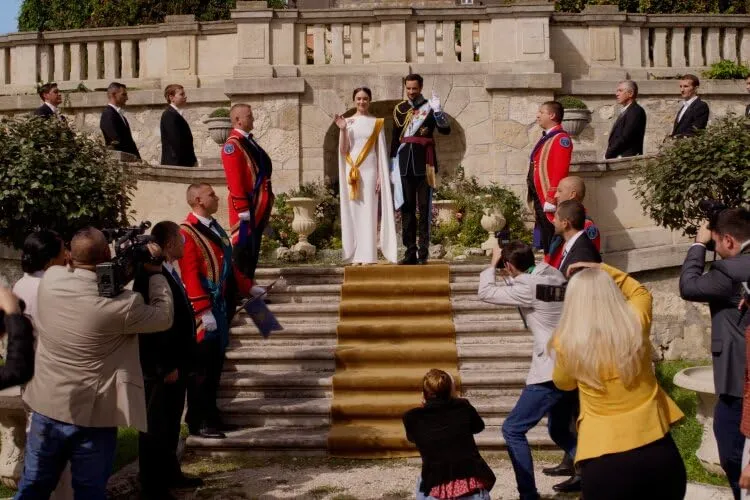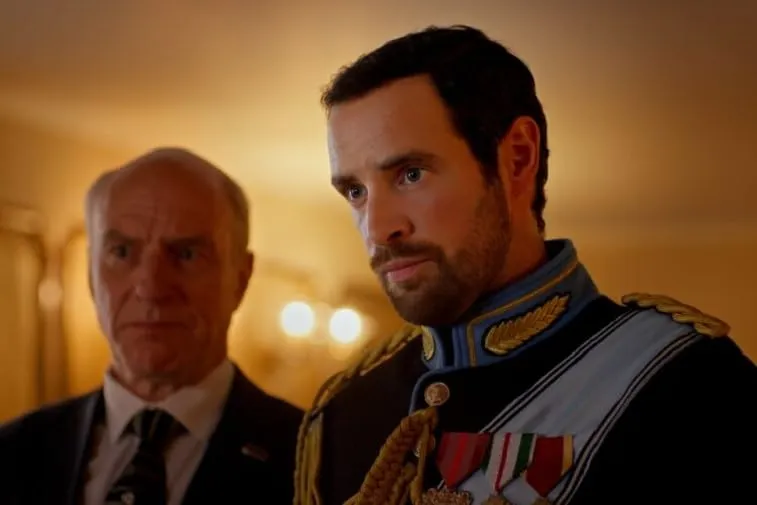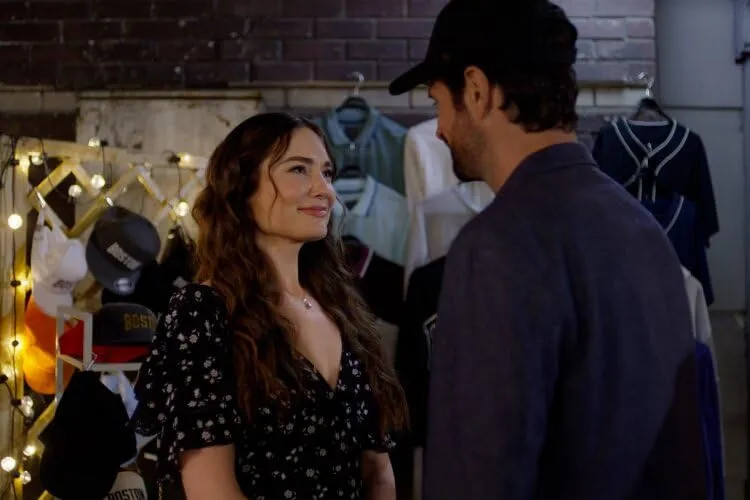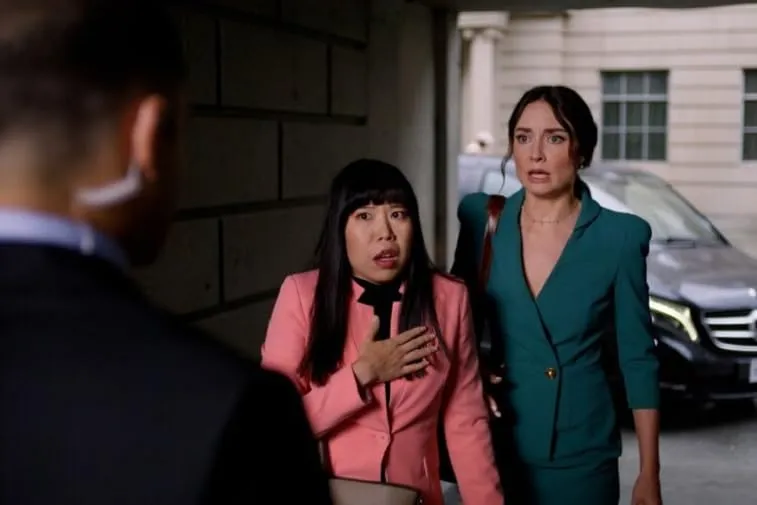The Royal We opens with a straightforward narrative spark: Princess Coralina’s abrupt elopement with a plumber dissolves a centuries‑old treaty, thrusting her younger sister, Bea, into the role of heir and reluctant peacekeeper. Screenwriters employ a clean three‑act framework, using this diplomatic crisis as an inciting incident that ripples through every subsequent beat.
Act two pivots on tonal contrasts—formal court banter gives way to late‑night pizza runs and impromptu bowling alleys—cleverly illustrating how Bea’s grounded perspective unsettles palace protocol and reshapes Desmond’s princely reserve into genuine warmth.
Time jumps are handled briskly, skipping past initial awkwardness to focus on how media frenzy and social‑media pop‑ups heighten stakes. These montages serve as both comedic punctuation and narrative shorthand, though they occasionally sprint ahead of character moments that deserve more breathing room. Still, the story’s architecture remains transparent: a political engagement evolves into real affection, conflict resolution becomes narrative climax, and the final act reframes the power dynamic when Bea brokers peace without a royal wedding.
Plot Mechanics and Narrative Flow
Scottish‑born screenwriters lean into a classic three‑act design, opening with an official engagement shoot between Princess Coralina and Prince Desmond. This meticulously staged tableau establishes political stakes immediately: two rival kingdoms bound by dynastic duty. Coralina’s abrupt elopement with a plumber in the very next scene snaps the frame apart and forces Desmond to confront how little agency he wields in his own story.
Act two shifts to Boston, where Beatrix “Bea” has cultivated a modest STEM foundation under the radar. Her life—peppered with grant meetings and cheeky exchanges with best friend Chloe—grounds the narrative in everyday concerns. When Desmond’s advisers locate Bea and the prince proffers a cold‑feet‑laced proposal, her instinctive refusal gives way to reluctant acceptance, setting the stage for an exploration of forced intimacy.
The central arc unfolds through a series of tonal pivots: gilded banquets segue into late‑night pizza runs, and stiff ballroom steps dissolve into bowling‑alley mishaps. Each sequence reveals layers of Bea and Desmond’s characters while social‑media call‑outs and viral hashtags introduce a satirical edge. The “people’s princess” moniker arrives just as quickly as the public scorn, underscoring how modern storytelling incorporates digital commentary as a narrative device.
In the third act, Bea applies her conflict‑resolution skills to a summit between feuding monarchs. What feels like a staged debate blossoms into genuine negotiation, allowing the kings to forgo the arranged marriage altogether. Yet the story circles back when both leads, untethered from political necessity, chase each other across a border checkpoint—Desmond in a motorcade, Bea on a Vespa—to reaffirm their bond.
The screenplay’s brisk time jumps keep momentum high, though occasional leaps sacrifice quieter emotional beats. Still, the film balances satirical flourishes and sincere moments with enough structure to guide viewers through its diplomatic‑turned‑romantic odyssey.
Character Dynamics and Performances
Princess Beatrix wears two hats with convincing grace: as a hands‑on STEM advocate in Boston and as the unexpected heir to a centuries‑old throne. Her emotional arc moves from post‑breakup slumps—mascara streaks and ice‑cream binges—to steely confidence in diplomatic chambers. Mallory Jansen captures this shift with ease, toggling between dry humor in her candid exchanges with Chloe and quiet strength when she brokers peace. Her wit feels genuine rather than scripted, and small gestures—like a hesitant smile when she discovers Desmond’s softer side—underscore her journey.
Prince Desmond begins as a poised figurehead, bound by protocol and polo matches. His thawing is gradual: a raised eyebrow over too‑hot pizza, laughter at gutter‑ball bowling, brief casual attire hiding an earnest man beneath the royal regalia. Charlie Carrick balances formality and warmth, especially in scenes where Desmond quietly absorbs Bea’s critiques of court life. The result is chemistry that builds organically, not through forced sparks but mutual respect.
The supporting cast adds texture without overwhelming the leads. Rae Lim’s Chloe supplies comic relief, her quips landing with perfect timing and rooting Bea’s world in relatable friendship. Edwin, played with gentle menace, reminds us how absurd royal bureaucracy can be—his fussy attention to protocol contrasts sharply with Bea’s blunt pragmatism. The kings and queens resemble caricatures at times—the indulgent father, the high‑strung queen—but their exaggerated reactions underscore the stakes of dynastic politics.
As an ensemble, these characters amplify key themes. Media consultants and border guards might seem peripheral, but they mirror the central tension between public image and private desire. Group scenes blend sincerity with satire: a summit meeting framed like a boardroom pitch, public declarations spilling into social‑media frenzy. Together, they reinforce the film’s careful balance of romance and political intrigue, demonstrating how even supporting roles contribute to the narrative’s momentum.
Subtext and Thematic Layers
The Royal We quietly upends the fairy‑tale formula by leaning into its own meta‑awareness. The recurring “royal we” gag isn’t just a pun—it signals the film’s intent to question the equation of princess plus prince equals cosmic bliss. Forced makeovers and scripted photo‑ops frame surgical shifts from modern woman to courtly trophy, underscoring how outmoded norms persist even within glossy backdrops.
Bea’s STEM program monologue crystallizes the film’s feminist undercurrent without veering into insufferable sermonizing. When she critiques narratives that cast girls as passive onlookers, the screenplay nods to a broader trend of romantic comedies adopting advocacy as plot device. Yet her transition from reluctant bride to active negotiator feels earned: she isn’t a rallying cry in heels, but a strategist who leverages her professional expertise in high‑stakes diplomacy.
Identity fractures between public and private surface repeatedly. In Boston, Bea moves through coffee shops unseen; in palace corridors, every glance is dissected by headline‑hungry tabloids. Desmond’s arc mirrors this split: polo whites give way to casual shirts, signaling a raw self beneath ceremonial armor. Their dual struggles tap into a storytelling shift where protagonists juggle authentic selves against performative roles—a motif increasingly visible in prestige television’s blur of personal and public spheres.
At its core, the arranged marriage serves as geopolitical shorthand—an echo of historical romances that married off land and influence. The summit sequence, pitched more like a corporate merger negotiation than a diplomatic ball, reframes monarchy as a vessel for conflict resolution, hinting at modern audiences’ appetite for procedural drama over courtly spectacle.
And then there’s the social‑media layer: pop‑up hashtags and scrolling feeds operate as a Greek chorus, satirizing our collective obsession with virality. These interstitials capture the double‑edged sword of fame—fueling Bea’s foundation and threatening her privacy. In weaving these threads, The Royal We nods to evolving storytelling tactics that blend traditional romance with digital‑age commentary.
Directorial Vision and Visual Craft
From its first scene, The Royal We establishes a directorial tone that flits between playful satire and genuine warmth. Director Anne Wheeler times comedic caricatures—royal advisers scribbling devil horns on engagement photos—with quieter character moments, like Bea’s pensive gaze after a failed text breakup. Montages of flashing hashtags accelerate the pace when social media commentary intensifies, while handheld shots and longer takes linger on the fallout of that public scrutiny.
Visually, the film contrasts Boston’s lived‑in flats—soft greys, cluttered desks, half‑empty coffee mugs—with the palace’s gleaming corridors lined in marble and gilded accents. Warm, natural light bathes off‑the‑record pizza runs, giving them an intimate glow, whereas formal court sequences employ symmetrical framing that underscores rigid protocol.
Costumes serve as silent narrators: Bea’s streetwear—jeans, layered sweaters—speaks to her autonomy, and as she adapts to royal life, she dons structured gowns whose color palettes subtly echo Eloria’s muted blues and Riverria’s rich burgundies. Set pieces complement this shift, moving from minimalist co‑working spaces to ornate thrones and banners.
Cinematography reinforces these divides. Close‑ups capture the flicker of vulnerability in Mallory Jansen’s eyes, while wide shots at diplomatic assemblies highlight the choreography of power. Static, almost formal blocking in palace halls gives way to loose, handheld freedom when Bea and Desmond escape for clandestine adventures—visually charting their journey from duty to discovery.
Music, Tone & Pacing
Composer Laura Bennett pairs modern pop cues with subtle orchestral swells, marking transitions as Bea moves from Boston anonymity into palace life. A gentle piano motif accompanies her introspection, while stately strings underscore treaty negotiations—each theme distinct yet woven into a cohesive soundscape.
Editing leans into quick‑cut montages for social‑media reactions, punctuating every hashtag with a blink‑and‑you’ll‑miss‑it flair. Dialogue exchanges snap back and forth with brisk timing, giving the leads’ banter a lived‑in feel rather than a staged sitcom rhythm.
Shifts between playful fish‑out‑of‑water scenes and earnest romantic interludes feel calibrated. The montage of their pizza‑and‑bowling date races ahead, then eases into longer takes when vulnerability surfaces. This vigilance in pacing ensures neither satire nor sentiment overstays its welcome, allowing the film’s tone to glide seamlessly between courtly absurdity and heartfelt connection.
Final Recommendation
Mallory Jansen and Charlie Carrick share a genuine spark, anchored by performances that balance wit and warmth, while the screenplay’s playful subversion of fairy‑tale norms and the production’s attention to visual detail infuse the film with unexpected depth.
Occasionally, secondary characters feel drawn too broadly and the final act accelerates through pivotal emotional moments. Fans of romances that blend modern feminist themes, digital‑age commentary and the comfort of classic fairy‑tale structure—peppered with late‑night pizza runs and bowling‑alley escapades—will delight in this offering. A solid above‑average effort, The Royal We rewards viewers seeking both charm and thoughtful storytelling.
Full Credits
Director: Clare Niederpruem
Writers: C. Jay Cox, Anne Black, Clare Niederpruem
Producers: Jeffery Beach, Kristina Kambitova, Phillip J. Roth
Executive Producers: Samantha Sprecher
Cast: Mallory Jansen (Beatrix), Charlie Carrick (Desmond), Rae Lim (Chloe Hargraves), Simon Kunz (Edwin Thewit-Moorland), Michael Howe (King Richmond), Carolyn Backhouse (Queen Leupinia), Nicola Posener (Princess Coralina), Simon Shackleton (King Winston), Jacinta Mulcahy (Queen Marguerite), Adam Woodward (Cody the Plumber), Jenna Boyd (Ula), Yavor Gadzhev (Lead Agent), Kate Nichols (Alice), Max Kraus (Rooster), Vincent Molli (Photographer), Roy Hill (Reporter #1), Sabrina Hill (Reporter #2)
Director of Photography (Cinematographer): Alexander Krumov
Editor: Rafi Spivak
Composer: Tommy Fields
The Review
The Royal We
The Royal We delivers a clever spin on familiar romance tropes, anchored by genuine chemistry, disciplined narrative structure, and a refreshing nod to feminist themes. While occasional caricatures and a brisk final act undercut its ambitions, the film’s wit, strong leads, and visual polish make it a rewarding watch.
PROS
- Sparkling chemistry between the leads
- Smart subversion of fairy‑tale clichés
- Strong, coherent narrative arc
- Visually polished production design
- Fresh feminist perspective
CONS
- Secondary characters sometimes verge on caricature
- Final act feels hurried
- Social‑media montages can overshadow quieter moments
- Predictable diplomatic resolution



















































